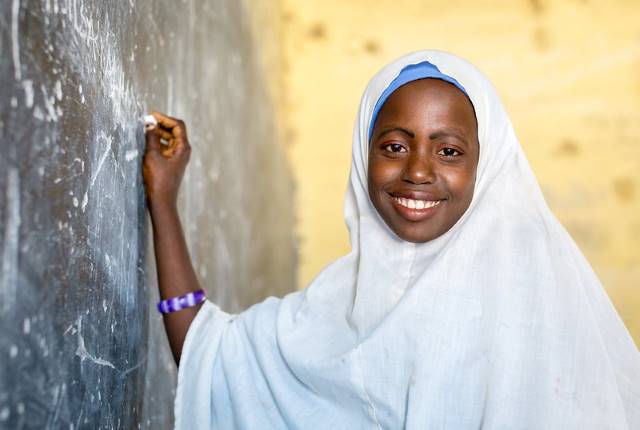The Fight to Improve Girls’ Education in Nigeria
 For women in Nigeria, education is a privilege because not all of them have access to it. Some people in Nigeria see education as a commodity and there are many children currently out of school. The Malala Fund estimates that 30% of girls aged 9-12 in Nigeria have never been to school. The children who are in school are more likely to be male. Some families have faced violence for sending their daughters to school. Nigeria faces several challenges in education but organizations are fighting to improve girls’ education in Nigeria.
For women in Nigeria, education is a privilege because not all of them have access to it. Some people in Nigeria see education as a commodity and there are many children currently out of school. The Malala Fund estimates that 30% of girls aged 9-12 in Nigeria have never been to school. The children who are in school are more likely to be male. Some families have faced violence for sending their daughters to school. Nigeria faces several challenges in education but organizations are fighting to improve girls’ education in Nigeria.
Fears of Retaliation
In 2018, 13.2 million Nigerian children were out of school and 60% of them were girls. At the time, this was the highest number in the world. Many parents cannot afford to send their children to school and often do not have access to transportation. Free primary education helps, but it is not enough. Others fear retaliation from sending their daughters to school. In 2018, Boko Haram abducted 110 schoolgirls as a message to parents. Boko Haram was very vocal when speaking out against Western education.
In 2021, Boko Haram still controls much of the northeastern part of Nigeria. Boko Haram has a distaste for Western education. In fact, the Islamist militant group’s name loosely translates to “western education is forbidden.” The 2018 kidnapping of 110 schoolgirls was not the group’s first attempt to stop girls’ education in Nigeria. Almost seven years ago, Boko Haram “took 276 girls from their school in Chibok in northeast Nigeria.” Many of these girls are still missing. Inciting fear is one of the ways Boko Haram keeps parents from sending their daughters to school.
Societal Norms
Girls accounted for 60% of children out of school in Nigeria. Poverty, child marriage, societal norms and violence are some of the reasons this rate is so high. Some of these girls had never been to school at all. Not seeing the value in sending their daughters to school if students are not receiving a quality education, families frequently marry girls off instead. Girls’ education in Nigeria has societal impacts as well. When girls have a secondary education, child mortality rates drop, child marriage rates decline and the lifetime earnings of girls increase. These positive outcomes help better society.
Ties With Poverty
One can also tie the lack of girls’ education in Nigeria to its poverty rate. In 2019, the poverty rate in Nigeria was 40% of the population, which equaled roughly 83 million people living below the poverty line. Northern Nigeria has low-quality education, which often means girls often do not get the education they need to thrive.
Period poverty is another factor that has impacted girls’ education in Nigeria over the years. Not being able to afford menstrual products has discouraged girls from going to school when menstruating. Menstrual products are a luxury that many cannot afford. Period poverty leads to many girls and women skipping work or school. Poor menstrual hygiene can lead to urinary tract infections and period poverty can cause depression or anxiety. All these factors can affect a girl’s education.
Previous Projects to Improve Girls’ Education in Nigeria
The Girls’ Education Project initially began in Nigeria in 2004. The focus was on supporting the Nigerian government in its efforts to achieve universal basic and primary education. A subsection of the project was the Girls’ Education Project 3 Cash Transfer Programme. Nigeria implemented it from 2014 to 2016 to improve girls’ education in Nigeria. The program mitigated the impact poverty had on girls’ enrollment in school. Through this program, social and economic opportunities for girls increased. More girls in Nigeria also completed basic education.
In 2020, UNICEF in Nigeria received a grant of $140,000. The grant went toward an online digital platform and strengthening states’ radio and television education programs as well as providing activity books, worksheets and assessment cards. The aid came amid the COVID-19 pandemic, which had a major impact on the education of children. UNICEF also provides “psychosocial support to children and teachers” and secures wash and hygiene resources for schools.
Today’s Efforts
UNICEF has implemented a program that aims to give all children access to quality education in a safe learning environment. This will take time, but its goal is to help the government achieve the Sustainable Development Goals (SDGs) by 2030. The key areas of focus for the program are access, learning and skills for emergencies and fragile contexts.
This means providing “gender-equitable access to quality education from a young age, quality learning outcomes and skills development and improved learning and protection for children in emergencies and on the move.” In 2021, 60 million schoolchildren gained access to primary or secondary education.
UNICEF has also established a girls’ education program that focuses on gender equality in education. By giving girls access to a safe education, inequality is reduced, allowing girls to reach their full potential. UNICEF helps governments and schools eliminate gender gaps in education, focusing on teacher training and removing gender stereotypes from learning materials. With help from organizations such as UNICEF, girls’ education in Nigeria will soon become commonplace.
– Ariel Dowdy
Photo: Flickr
